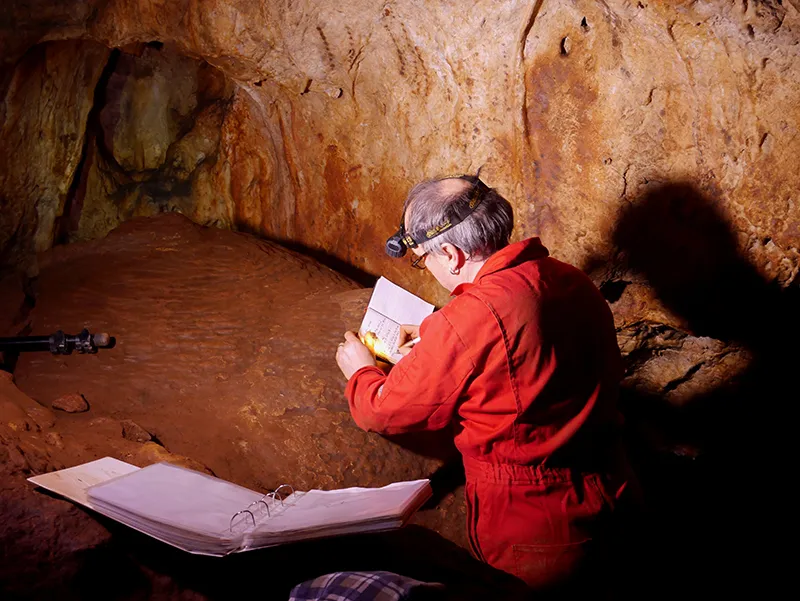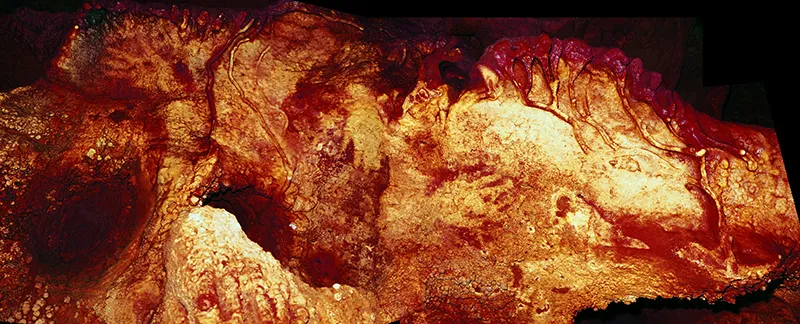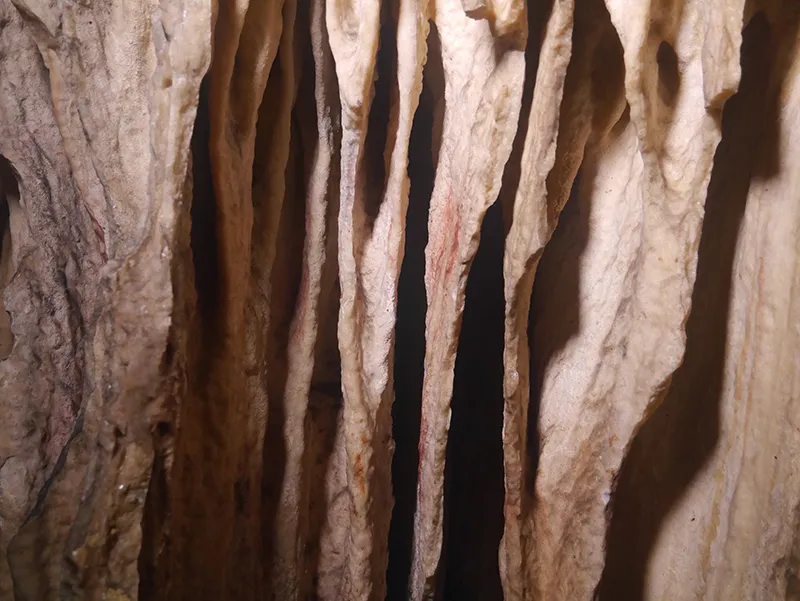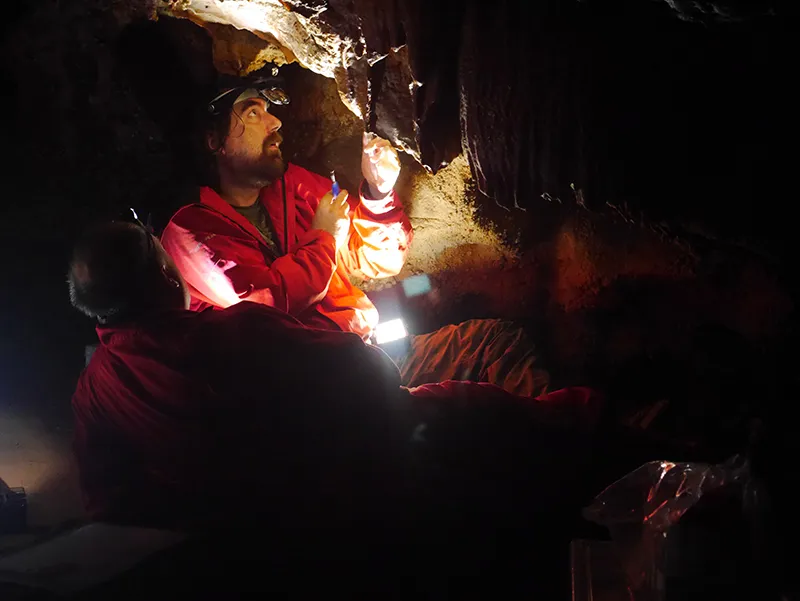Were Neanderthals the Earliest Cave Artists? New Research in Spain Points to the Possibility
Archaeologists pushed back the date of cave paintings at three sites to 65,000 years ago—20,000 years before the arrival of humans in Europe
/https://tf-cmsv2-smithsonianmag-media.s3.amazonaws.com/filer/4c/8d/4c8d40a2-9859-47e4-8f5b-ae4a38c0f8c0/fig_1_la_pasiega.jpg)
Put yourself in the distant past, 65,000 years ago, and imagine entering a cave in Spain. Keep in mind this was the era of megafauna, animals like saber-toothed cats and cave hyenas and cave bears that were 50 percent larger than modern grizzlies. “[Humans] would’ve used small torches and their field of view would’ve been so small, and the light would’ve been flickering,” says archaeologist Chris Standish, of the University of Southampton. “You have all these fantastic speleothems [formations like stalactites] in the cave and sometimes calcite crystals that sparkle. So it must’ve been quite amazing, but also very daunting.”
Yet humans entered the caves again and again, armed with their flickering torches and red or black pigments, all so they could leave their mark on the walls. For decades, these abstract artistic renderings have been a meager glimpse of life in the Ice Age, and evidence of the cognitive abilities of our ancient ancestors. Or so we thought.
In a paper published today in Science, Standish and others argue the paintings are too old to have been made by Homo sapiens, who only entered Europe sometime around 40,000 years ago. Instead, they think this art might’ve been the product of Neanderthals.
“It’s very exciting that they’re getting these dates for art, especially as we’ve been working towards arguing for the cognitive capacities of Neanderthals for many years,” says paleoanthropologist Clive Finlayson of the Gibraltar Museum, who wasn’t involved with the study but has previously studied Neanderthal rock engravings in Gibraltar. “The only word of caution is that there’s no direct evidence that this is Neanderthals. It’s inferred because of the age.”
In the past, archaeologists have struggled to accurately date cave art. While black, carbon-based designs can be analyzed with radiocarbon dating, the brilliant red pigment is made of minerals that don’t decay the way carbon does. In many cases, researchers have been forced to date the art indirectly, based on other artifacts or signs of habitation in the caves, like traces of hearth fires.
“At this point there’s probably somewhere between 5 and 10 percent of sites that have any sort of direct dating,” says paleoanthropologist Genevieve von Petzinger of the University of Victoria, who isn’t affiliated with the study. While she acknowledges that there’s no direct evidence here that Neanderthals were the ones doing the painting, “It’s a more likely explanation than humans ninja-ing in from Africa. Genetically speaking, we don’t have any evidence of humans being in Europe at all [during that period].”

To learn the age of the red paint in three Spanish caves—La Pasiega, Maltravieso and Ardales—researchers took 53 samples of stone from around the artwork. By analyzing the deposits that have covered the pigment in subsequent years, the archaeologists can find minimum dates for when the paint was applied. Because the carbonate deposits come from above the paint itself, that means it must have been placed on the wall sometime before.
This method, called uranium-thorium dating, has existed for about 20 years, but was previously considered too destructive for use in the caves since it required scraping large amounts of material from the walls. Now, as the technology for measuring radioactive decay has advanced, only a tiny amount of material is necessary. Prior to its use in archaeological settings, uranium-thorium dating was used to date corals and understand how the environment has changed over time.
Like radiocarbon dating, uranium-thorium dating relies on how the radioactive isotopes have decayed to find a date. Caves are particularly well suited to uranium-thorium, Standish says, because they’re not exposed to wind that can carry stray bits of thorium and skew the results. What they discovered in each of the three caves were minimum ages of 65,000 years and older—an astonishing number when considering that modern humans were suspected to arrive 25,000 years later.
“I think it was an excellent, really careful study and speaks to the fact that with these new technologies, we keep discovering exciting new things we didn’t have the capacity to discover before,” von Petzinger says. “Uranium-thorium dating is likely to be quite accurate, especially when used as carefully as they did.”

But not all researchers agree that uranium-thorium dates are valid. In a 2015 paper published in Quarternary International, paleoanthropologists Georges Sauvet, Randall White and others argued that uranium-thorium dating of Paleolithic art could be prone to overestimating and underestimating the age of the pigments. This is because cave formations sometimes grow in fits and starts, so the age could be unreliable, and because water can leach uranium away from the rock, again leading to miscalculated dates.
Although he couldn’t offer comprehensive comments on the study, Randall White, a paleoanthropologist with New York University, said that flaws of the dating technique combined with a lack of Neanderthal artifacts proving they are the ones who created the paintings makes him highly skeptical of Neanderthals as artists. “What is clear is that the current authors’ claim that their ‘results bring closure to this debate’ is wishful thinking,” White said by email.
This same criticism has been applied to earlier studies, including a 2012 paper in Science that examined artwork from 11 Spanish caves using uranium-thorium dating. For Georges Sauvet, the author of several papers critiquing uranium-thorium dating, there is no possible way for the method to be used to find accurate dates. “The causes of errors are so large and so frequent that no confidence could be allowed to this method,” he said by email. “The only possibility would be to check the validity of U/Th by cross-dating using C14 dating of the carbonate from the same speleothem [or cave formation].”

But Standish’s colleagues have issued their own rebuttal after the argument against uranium-thorium, and he says they took great pains to account for possible inaccuracies in their most recent research.
“If you imagine a crust of carbonate over pigment, rather than removing in one go, we sequentially sample it with a scalpel,” Standish says. “When we date them we can make sure they’re giving us a sequence of ages consistent with how they form. If there’s uranium leaching, you’d get it on the surface, so it would be older.” He adds that while radiocarbon is often the go-to dating tool of archaeologists because it’s been around longer and repeatedly proven its value, researchers should avail themselves of all possible technologies at their disposal for dating.
If this new research does stand up to scrutiny, it might be one more nail in the Neanderthals-were-mindless-brutes coffin. After all, we already have evidence that Neanderthals used tools, that they may have decorated themselves with bird feathers, and that they engaged in some sort of burial rituals. They’ve also done more than just chisel engravings or paint abstract figures in caves—they built underground rings of stone 175,000 years ago in French caves.

“The bar has always been set particularly high in terms of evidence for Neanderthal modernity, symbolic behavior and art creation, in comparison to the standards set for modern humans,” said paleoanthropologist Amy Chase of Memorial University by email. “The idea that maybe we were the only species who could transfer our ideas onto a 2-dimensional space allowed us to consider this as a possible difference in cognitive and maybe even physical abilities between Neanderthals and modern humans.” Having to rethink that paradigm is something that not all researchers are comfortable with, especially because all of the evidence has to be interpreted second-hand—we don’t have any Neanderthals hanging around to ask about their thought processes.
Anthropologists like Finlayson argue we should evaluate how hominins behaved in their environments rather than comparing them to one another. If we did that everywhere, as he’s done in Gibraltar, we’d find that the different hominin species made use of the same resources.
And then there’s the issue of defining them as different species at all. “We’ve spent a long time describing the physical differences of Neanderthals and modern humans from an anatomy perspective, but it seems clear to me that if there was so much interbreeding, these guys on the ground didn’t see each other that differently,” Finlayson says. “Maybe we’ve overemphasized the differences and forgotten about the similarities.”
/https://tf-cmsv2-smithsonianmag-media.s3.amazonaws.com/accounts/headshot/lorraine.png)


/https://tf-cmsv2-smithsonianmag-media.s3.amazonaws.com/accounts/headshot/lorraine.png)